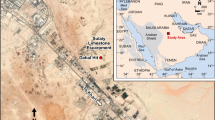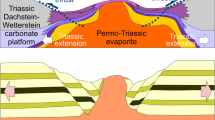Abstract
Qiangtang Basin is a large Mesozoic marine sedimentary basin located on the northern Qinghai-Tibet plateau. Multiple sets of evaporites were observed in the Middle Jurassic Buqu Formation through field outcrop description and thin sections analysis, so as to form the sets of evaporite–carbonate sedimentary sequences. The evaporites in the Buqu Formation are represented by gypsum and anhydrite rocks that contain minor secondary diagenetic features such as massive, rosette, chicken-wire, and satin spar gypsum. Two lithofacies association types were identified in the Buqu Formation, including sparry oolitic limestone–dolomite–gypsum/anhydrite and micrite–carbonaceous mudstone–gypsum/anhydrite. The former was deposited in an intertidal–supratidal (tidal flat) setting and the latter was deposited in a subtidal lagoon setting. Two depositional sequences were distinguished, including Buqu sequence 1 and Buqu sequence 2. Gypsum of the intertidal setting is mainly developed in a lowstand system tract in both Buqu sequences 1 and 2, while gypsum of the subtidal setting is mainly developed in a highstand system tract in Buqu sequence 2. Combining the measured evaporites thickness in the field with sedimentary facies analysis, the distribution of the Middle Jurassic Buqu Formation evaporites is clear in the Qiangtang Basin, which may serve as a local seal for oil and gas plays in this region.

Modified from Li et al. 2009







Modified from Tucker 1991)


Similar content being viewed by others
References
Catuneanu O, Galloway WE, Kendall CGSTC, Miall AD, Posamentier HW, Strasser A et al (2011) Sequence stratigraphy: methodology and nomenclature. Newsl Stratigr 44:173–245
Dunham RJ (1962) Classification of carbonate rocks according to depositional texture. AAPG Mem 1:108–121
Fu XG, Wang J, Wu T, He JL (2010) Stratigraphy and paleoenvironment of the Quemo Co Formation in Shengli River area, northern Tibet. Geol China 37:1305–1312 (in Chinese with English abstract)
Jiang L, Worden RH, Cai CF (2015) Generation of isotopically and compositionally distinct water during thermochemical sulfate reduction (tsr) in carbonate reservoirs: triassic feixianguan formation, sichuan basin, China. Geochim Cosmochim Acta 165:249–262
Kinsman DJ (1966) Gypsum and anhydrite of recent age, Trucial Coast, Persian Gulf. In: Proceedings of the 2nd Symposium on Salt. Northern Ohio, Geological Society, Cleveland, OH, pp 302–326
Li YT, Luo JN (2001) Formation of the qinghai-tibet plateau[M]. Science press, Beijing, pp 111–177 (in Chinese)
Li ZX, Wang J, Wang ZJ, Li R, Du BW (2009) Lithologic and Reservoir Physical Properties of Carbonate Rocks in the Middle Jurassic Buqu Formation inside Qiangzi-2 Borehole of the Qiangtang Basin in Northern Tibet. Acta Geoscientica Sinica 30:590–598 (in Chinese with English abstract)
Luo JN, Zhu ZF, Xie Y, Ye HF, Tong ZY, Shen QM (2003) The gypsolith and its bearings on the oil and gas exploration in the Qiangtang Basin in northern Xizang and southern Qinghai. Sediment Geol Tethyan Geol 23:1–8 (in Chinese with English abstract)
Ma BY, Wang XL, Wang GH, Xu HY, Li SL (2009) Carbonate microfacies and sedimentary environment of the Middle Jurassic Buqu Formation in the Gongri area, eastern part of the Qiangtang basin, Tibet, China. Geol Bull China 28:609–617 (in Chinese with English abstract)
Maiklem WR, Bebout DG, Glaister RP (1969) Classification of anhydrite—a practical approach. Bull Can Pet Geol 17:194–233
Manzi V, Gennari R, Lugli S, Roveri M, Scafetta N, Schreiber BC (2013) High-frequency cyclicity in the mediterranean messinian evaporites: evidence for solar-lunar climate forcing. J Sediment Res 82:991–1005
Nan ZB, Li YT, Guo ZJ (2008) Hydrocarbon show and correlation between oil and source rock in the qiangtang basin. Pet Geol Exp 30:503–507 (in Chinese with English abstract)
Ortí F, Rosell L, Gibert L, Moragas M, Playà E, Inglès M et al (2014) Evaporite sedimentation in a tectonically active basin: the lacustrine las minas gypsum unit (Late Tortonian, se Spain). Sediment Geol 311:17–42
Qin JZ (2006) Oil source and hydrocarbon migration process in Qiangtang Basin, Qingghai-Tibet Plateau. Pet Geol Exp 28:450–457 (in Chinese with English abstract)
Schreiber BC, Tabakh El (2000) Deposition and early alteration of evaporites. Sedimentology 47:215–238
Shen QM, Ji YL (2001) Mesozoic sedimentary facies and oil and gas reservoir cap rock characteristics of the qinghai-tibet plateau. Science Press, Beijing, pp 241–256 (in Chinese)
Tan FW, Wang J, Wang XL, Du BW (2002) The Qiangtang Basin in Xizang as the target area for the oil and gas resources in China. Sediment Geol Tethyan Geol 22:16–21 (in Chinese with English abstract)
Taylor JCM (1998) Upper Permian - Zechstein. In: Glennie KW (ed) Petroleum geology of the North Sea. Blackwell Science Ltd, Oxford, pp 174–211
Tucker ME (1991) Sequence stratigraphy of carbonate evaporite basins—models and application to the upper permian (zechstein) of northeast England and adjoining north-sea. J Geol Soc 148:1019–1036
Veizer J, Hoefs J (1976) The nature of 18O/16O, and 13C/12C secular trends in sedimentary carbonate rocks. Geochim Cosmochim Acta 40:1387–1395
Wang J, Tan FW, Li YL (2004) Analysis on sedimentary basin oil and gas resource potential of the qinghai-tibet plateau. Science Press, Beijing, pp 1–88 (in Chinese)
Wang CS, Li YL, Li YT (2006a) Discussion on evaluation of oil and gas resources in Qinghai-Tibet Plateau. Acta Prtrolei Sinica 27:1–7 (in Chinese with English abstract)
Wang CS, Li YL, Li YT (2006b) Discussion on evaluation of oil and gas resources in Qinghai-Tibet Plateau (in Chinese). Acta Petrolei Sin 27:1–7
Warren JK (2006) Evaporites: sediments, resources and hydrocarbons. Springer, Berlin, pp 1–1019
Warren JK (2010) Evaporites through time: tectonic, climatic and eustatic controls in marine and nonmarine deposits. Earth Sci Rev 98:217–268
Xie Y, Wang J, Liu JD, Luo JN, Zhang SN, Yang BX, Li MH (2002) Carbon, Oxygen and strontium isotopic responses of Carbonate rocks and the middle jurassic sIuence stratigraphy in the Nadigangri area, Oiangtang Basin. Acta Sedimentol Sin 20:188–196 (in Chinese with English abstract)
Yu YJ, Yang XP, Lei ZY, Zhang H, Lu WY (2002) A Preliminary Study of the Mesozoic-Cenozoic Palaeoclimate Evolution in Chalangla Areas, Qiangtang Basin, Northern Tibet. Acta Geosci Sin 23:55–62 (in Chinese with English abstract)
Zeng SQ, Wang J, Chen M, Fu XG, Wu T, Xiong XG (2012) Geological age, paleoclimate and petroleum geological characteristics of the upper part of the Suowa Formation in the North Qiangtang Basin. Geoscience 26:10–21 (in Chinese with English abstract)
Zhang SF, Zhang CM, Hu MY, Gong WP, Xiao CT, Liu AH et al (2009) Base level change and depositional filling response of jurassic in the qiangtang basin of tibet. Sci China 52:143–151
Zhao B, Yi HS, Lin JH, Shi ZQ, Li BH, Huang JJ (2002) Stratigraphy, paleontology, and sedimentary environment of the Jurassic Buqu Formation at Maliao Mountain, northern Qiangtang basin. Reg Geol China 21:415–420 (in Chinese with English abstract)
Acknowledgements
We thank Jiasheng Zhou, senior engineer, and Zhiwen Wang, senior engineer, from the Southern Exploration Division Company, SINOPEC, China, who provided guidance and help in the field. We thank LetPub (http://www.letpub.com) for its linguistic assistance during the preparation of this manuscript. Our deepest gratitude goes to the editors and the anonymous reviewers for their careful work and thoughtful suggestions that have helped improve this paper substantially.
Funding was provided by Major State Basic Research Development Program (Grant No. 2012CB214802).
Author information
Authors and Affiliations
Corresponding author
Rights and permissions
About this article
Cite this article
Yang, X., Fan, T., Tang, S. et al. Sedimentology and sequence stratigraphy of evaporites in the Middle Jurassic Buqu Formation of the Qiangtang Basin, Tibet, China. Carbonates Evaporites 32, 379–390 (2017). https://doi.org/10.1007/s13146-016-0324-3
Accepted:
Published:
Issue Date:
DOI: https://doi.org/10.1007/s13146-016-0324-3




